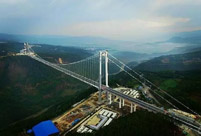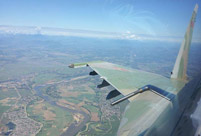

BEIJING, April 28 -- The era of easy money seems to be drawing to a close for Chinese banks as annual results showed their bad loans piling up fast while profits slowed sharply last year.
All 16 lenders listed on China's A-share market have now released their annual earnings, all posting higher non-performing loans (NPLs) in 2015. Some saw bad loans jump more than 50 percent year on year.
Chinese lenders, including listed and unlisted ones, had 1.27 trillion yuan (196 billion U.S. dollars) of bad loans by the end of 2015, up 51.2 percent year on year, according to data from China's banking regulator. The ratio of NPLs to total loans had gone up for 10 consecutive quarters by the end of 2015.
Meanwhile, the combined net profits of all Chinese lenders climbed only 2.43 percent, compared with 9.65 percent in 2014, the data showed.
The Agricultural Bank of China, one of the country's "big four" commercial banks, was one of those under intensified pressure. It saw net profits edge up merely 0.7 percent year on year, while its NPL ratio rose to 2.39 percent from 1.54 percent a year earlier.
The increase in bad loans came as China moved to reduce the capacity of oversupplied industries and close "zombie companies," those that survive only on bailouts, to restructure and upgrade a slowing economy.
Facing extreme financial difficulty or already having been shut down, many firms were unable to pay back debts, and that had a knock-on effect on other firms tied to them in business, said Zeng Gang, a banking researcher with the Chinese Academy of Social Sciences.
Most non-performing loans went to manufacturing, wholesale and retail trade, as well as the mining industry, according to the banks' annual reports.
Meanwhile, dud loans in the country's mid-west rose more significantly than in the east.
"The mid-west has a high concentration of steel and coal firms, which are at the forefront of capacity reduction," said Xiao Yaofei, a researcher at the Guangdong Institute for International Strategies.
The asset quality pressure on Chinese banks will continue in 2016, global rating agency Moody's forecast earlier this month.
The passing of a time when banks made money effortlessly is in line with China's economic transition, said Mo Kaiwei, a researcher with the China Academy of Regional Finance.
"The banking industry goes with the economic cycle. It is quite normal that banks' asset quality and profits decrease when China's economy faces greater downward pressure," he wrote in an analysis article.
China's economic growth slowed further to 6.7 percent in the first quarter of this year as a result of an industrial glut, cooled property investment and sagging foreign trade.
Are the banks capable of digesting the bad loans and reining in the risks?
Mo is among the analysts who think so, citing fast growth in business revenue, steady income from interests and adequate loan loss provisions, expenses that are set aside as allowances for bad loans.
While banks' own profits have so far been used to write off bad loans, there has been consideration of a debt-equity swap program that would allow banks to exchange bad debt for stocks in the companies concerned. China is also ready to let banks issue asset-backed securities collateralized by NPLs.
Even at its current level, the NPL ratio of Chinese banks is still far below that in other major economies, whose NPL ratios range from 3 percent to 5 percent, Mo noted.
Chinese lenders' NPL ratio stood at 1.67 percent at the end of 2015, according to official data.
Mo believes rising bad loans are not necessarily a bad thing, as the phenomenon could force banks to be more prudent when extending credit and develop a more sophisticated business model.
 Beijing Style: ready for bare legs
Beijing Style: ready for bare legs Top 10 Asian beauties in 2016
Top 10 Asian beauties in 2016 Amazing scenery of Xisha Islands
Amazing scenery of Xisha Islands Enthusiasts perform Kung Fu at Wudang Mountain
Enthusiasts perform Kung Fu at Wudang Mountain Stunning photos of China's fighter jets in drill
Stunning photos of China's fighter jets in drill Old photos record the change of Sichuan over a century
Old photos record the change of Sichuan over a century Asia's longest and highest suspension bridge to open to traffic
Asia's longest and highest suspension bridge to open to traffic China's first interactive robot looks like a beauty
China's first interactive robot looks like a beauty Vietnamese Su-30 fighters fly over Nanwei Island in South China Sea
Vietnamese Su-30 fighters fly over Nanwei Island in South China Sea Top 20 hottest women in the world in 2014
Top 20 hottest women in the world in 2014 Top 10 hardest languages to learn
Top 10 hardest languages to learn 10 Chinese female stars with most beautiful faces
10 Chinese female stars with most beautiful faces China’s Top 10 Unique Bridges, Highways and Roads
China’s Top 10 Unique Bridges, Highways and Roads Canberra’s submarine deal tilts security balance
Canberra’s submarine deal tilts security balance Ant Financial gets closer to IPO with massive financing
Ant Financial gets closer to IPO with massive financing  As survey shows 77% believe cruel TCM practices should stop, firms under pressure
As survey shows 77% believe cruel TCM practices should stop, firms under pressure International plus-sized contest in Beijing helps women show that beauty comes in all shapes and sizes
International plus-sized contest in Beijing helps women show that beauty comes in all shapes and sizesDay|Week